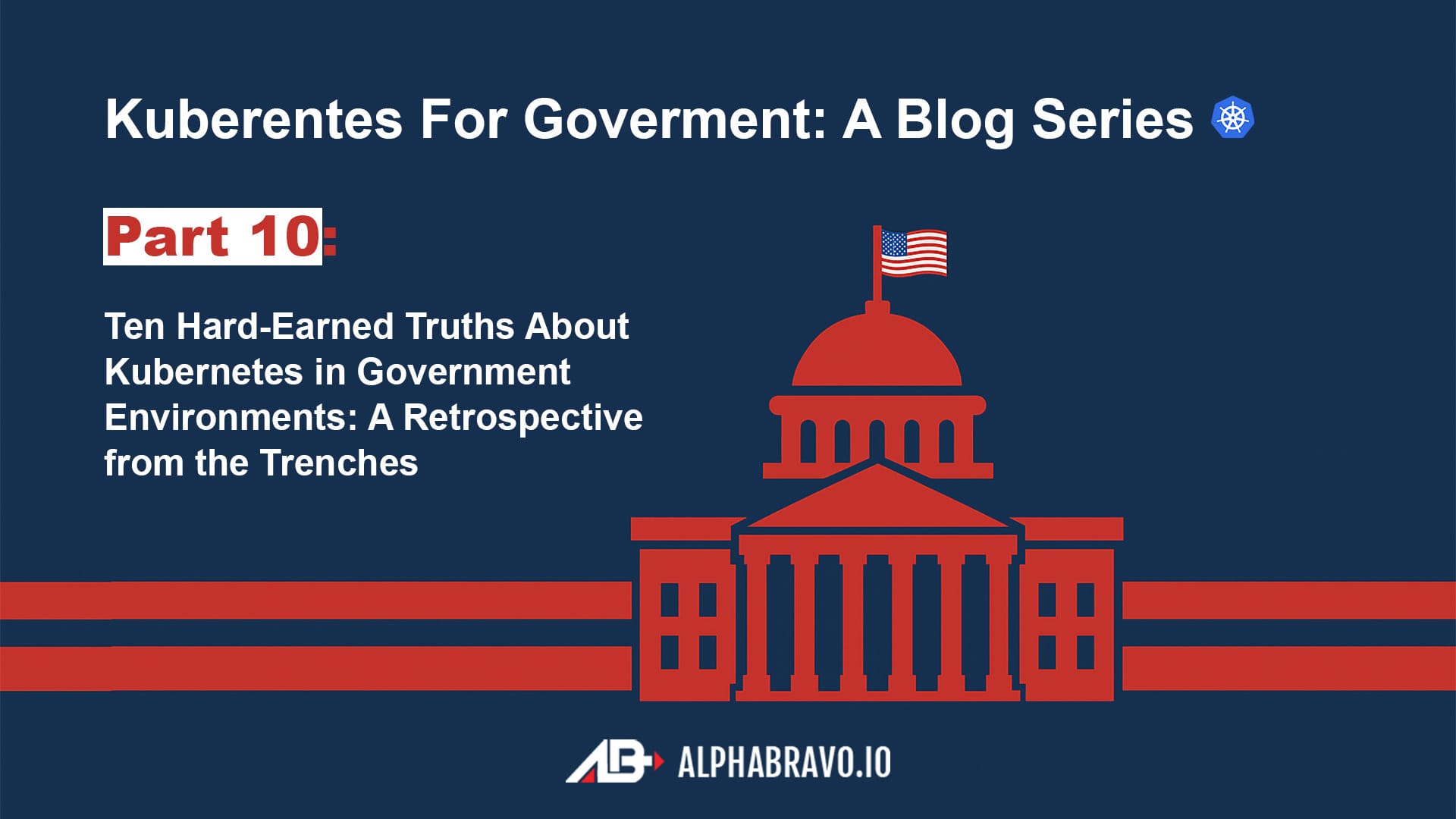Ten Hard-Earned Truths About Kubernetes in Government Environments: A Retrospective from the Trenches (Part 10)
Ten Hard-Earned Truths About Kubernetes in Government Environments: A Retrospective from the Trenches

Deploying Kubernetes in Department of Defense (DoD) and Federal environments is like teaching a grizzly bear to juggle chainswaws – theoretically possible, but requiring equal parts technical precision, bureaucratic finesse, and a healthy respect for the consequences of failure. Over three years of implementing container orchestration across classified networks, air-gapped tactical systems, and compliance-heavy enterprise environments, we’ve compiled these lessons into a survival guide for engineers navigating this unique intersection of cutting-edge technology and century-old procurement processes.
1. Security Classifications Are Your New Best Frenemy
The Impact Level Tango
The DoD’s security Impact Levels (IL2-IL6) don’t just influence your architecture – they dictate it. As detailed in our earlier exploration of DoD security frameworks, IL5 deployments require cryptographic modules validated against FIPS 140-3 standards, while IL6 clusters demand physical separation equivalent to building a Faraday cage inside a SCIF. The cruel irony? The more secure your environment, the harder it becomes to actually secure it – patching an IL6 cluster involves a 14-step manual process that makes defusing a nuclear warhead look straightforward.
The STIG Paradox
Implementing DISA’s Security Technical Implementation Guide (STIG) for Kubernetes (91 controls and counting) often creates Schrödinger’s cluster: a system that’s simultaneously compliant and non-functional. We learned the hard way that STIG requirement V-242535 (“The Kubernetes component manager must enforce ports, protocols, and services management”) conflicts with CNI plugins that dynamically assign ports. The solution? A 47-page waiver request explaining why cloud-native networking behaves differently than 1990s-era switches.
2. Multi-Cluster Architectures: Not Just a Good Idea, It’s the Law
Global Control Plane or Global Headache?
The CNCF Multi-Cluster Kubernetes Reference Design mandates a “global view across all enclaves,” which sounds elegant until you’re debugging cross-cluster service mesh failures across three classification levels. Our breakthrough came when we stopped trying to force Istio into tactical edge environments and instead adopted a hybrid approach using Submariner for layer 3 connectivity and custom CRDs for secret synchronization.
The Air-Gap Tax
Deploying to disconnected environments (like the F-16 maintenance systems we supported) adds a 300% overhead tax to every operation. Container images approved for IL5 can’t simply be airlifted via USB – they require Chain of Custody forms signed in triplicate and validated against a SHA-256 manifest that’s older than the junior airman transporting it.
3. Network Policies: The Art of War in Kubernetes
CNI Showdown at the OK Corral
Our performance benchmarks revealed stark differences between CNI plugins under DoD workloads. Cilium’s eBPF-powered data plane maintained 8.9 Gbps throughput with complex L7 policies, while traditional iptables-based solutions became unstable beyond 500 pods. The catch? Getting Cilium’s Hubble UI approved for IL5 required six months of FedRAMP Moderate documentation – time we spent writing custom Prometheus exporters instead.
The Zero Trust Mirage
“Network segmentation first” sounds great until you’re trying to implement NIST 800-207 in a cluster supporting both public-facing services and TS/SCI workloads. Our compromise: a nested service mesh architecture with Envoy handling L7 policies and Calico enforcing L4 rules, creating concentric security rings that would make the Pentagon proud.
4. Immutable Infrastructure: Because Change Is the Enemy
The Golden Image Gambit
DoD’s shift to immutable infrastructure (mandated in IL5+ environments) turned our container build process into a cryptographic ritual. Each image layer now gets signed with a PIV card, validated against a hardware security module, and recorded in a blockchain ledger that’s more guarded than the nuclear football. The upside? We haven’t seen configuration drift in two years. The downside? Updating nginx now requires a Congressional hearing.
5. RBAC: When “Need to Know” Meets “No, You Can’t”
The Colonel Paradox
Explaining Kubernetes RBAC to flag officers is like teaching quantum physics to a golden retriever – they’ll happily wag their tail while you drown in existential dread. Our breakthrough came when we mapped military ranks to cluster roles: Colonels get view access, Generals get edit, and anyone requesting cluster-admin gets assigned to latrine duty.
The JEDI Principle
(Joint Enterprise Directory Integration) became our mantra after discovering 87% of access issues stemmed from stale Active Directory groups. Our solution: a custom Kubernetes controller that syncs PAC files from DISA’s Enterprise Directory every 30 seconds, complete with a two-person rule for role binding changes.
6. Compliance Documentation: The Paperwork Will Continue Until Morale Improves
The ATO Odyssey
Securing an Authority to Operate (ATO) for our first production cluster took longer than the Manhattan Project. The 1,342-page Continuous ATO package included dependency trees for 87 open-source components, third-party penetration test results, and a notarized letter from Linus Torvalds (we’re still waiting on that last one).
7. Autoscaling: The Delicate Dance of Resource Management
HPA: Hope, Pray, Adjust
Tuning Horizontal Pod Autoscalers for missile defense systems taught us that “scaling” takes on new meaning when latency budgets are measured in microseconds. Our winning formula combined custom metrics from NVIDIA’s dcgm-exporter with a reinforcement learning model that predicted threat windows from SIGINT feeds.
8. Cost Control: Because Even the Government Hates Waste
The Showback Awakening
Implementing Kubecost in our IL4 environment revealed that 40% of cluster capacity was wasted on zombie namespaces from decommissioned projects. Our fix? A “Fiscal Friday” initiative where unpaid interns hunt down unused resources like Pac-Man chasing ghosts.
9. Disconnected Operations: When the Internet Is a Myth
The Helm Chart Time Machine
Air-gapped deployments require a 1950s approach to dependency management. Our container registry now contains every artifact since Kubernetes 1.12, preserved like digital amber. Upgrading a cluster involves carrying a hard drive through three security checkpoints – we’ve started calling it the “Sneakernet CD pipeline”.
10. Automation: The Only Way to Stay Sane
The GitOps Gambit
ArgoCD became our lifeline for managing 200+ clusters across security domains. Our custom plugin enforces STIG checks during sync operations, rejecting any manifest that doesn’t include proper PodSecurityContext configurations. The result? We’ve reduced configuration errors by 93% while increasing auditor-induced migraines by 400%.
Parting Wisdom for the Weary
The path to Kubernetes enlightenment in government environments is paved with expired certificates, angry auditors, and the shattered dreams of engineers who thought “YAML is easy.” Yet beneath the paperwork avalanche lies a profound truth: every control bypassed, every waiver approved, and every stubborn general converted to the cloud-native cause moves the mission forward. As we’ve learned through blood, sweat, and security reviews, the real Kubernetes expertise isn’t in mastering etcd – it’s in mastering the art of explaining etcd to someone who still uses a flip phone.
So polish your STIG checklists, charge your CAC readers, and remember: in the world of government Kubernetes, the only thing harder than getting a cluster approved is keeping it running. But when that CI/CD pipeline finally pushes validated code to a nuclear submarine while meeting all NIST controls – well, that’s the kind of victory that makes the 3 AM pages worthwhile.

